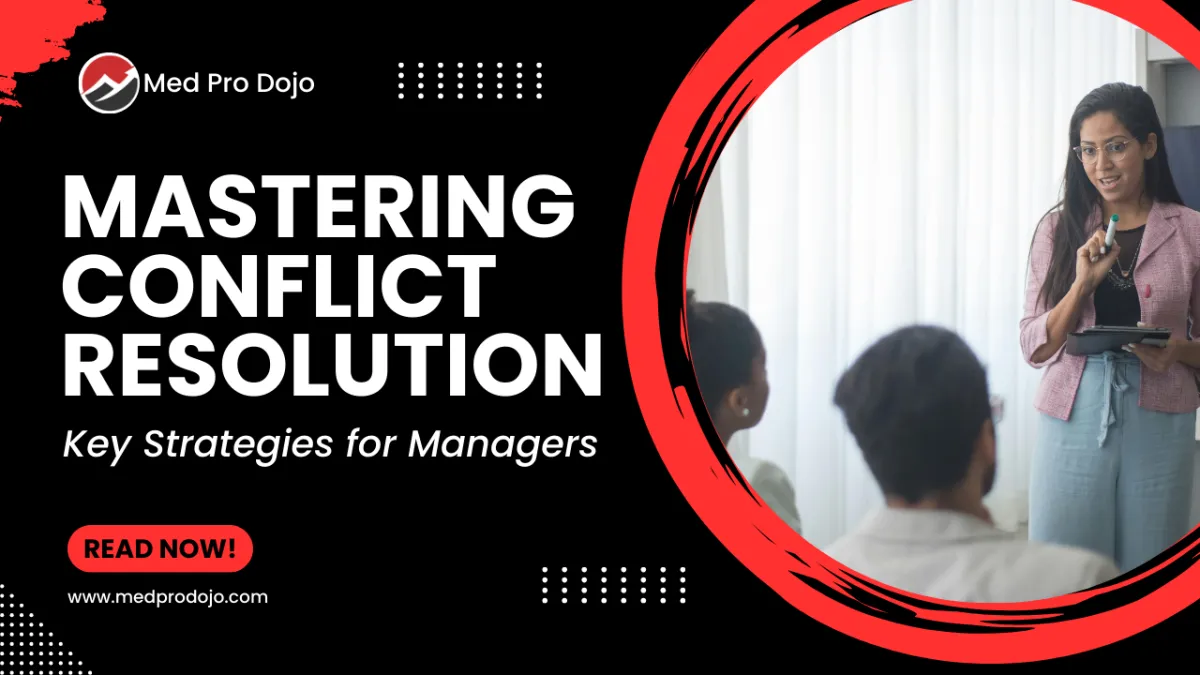
Mastering Conflict Resolution: Key Strategies for Managers

In any team, conflicts are inevitable. As a manager, it's crucial to navigate these conflicts effectively to maintain a harmonious and productive work environment. This article delves into four essential strategies for conflict resolution: recognizing the signs of conflict, staying neutral and objective, encouraging open communication, and focusing on solutions.
Recognize the Signs of Conflict
Identify Early Signs
The first step in effective conflict resolution is recognizing the early signs of conflict. Imagine you’re managing a team in a busy medical practice. You notice that Sarah, usually a vibrant and communicative team member, has become withdrawn and less engaged in team meetings. John, another team member, has shown a sudden drop in productivity and missed a few days of work without much explanation. Meanwhile, during a meeting, you observe Alex crossing his arms and avoiding eye contact when discussing certain topics. These behavioral changes are early indicators that something is amiss.
Behavioral Changes: Team members may become withdrawn, less communicative, or unusually aggressive.
Example: Sarah, who used to actively participate, now sits silently, avoiding interaction with colleagues.
Decreased Productivity: A noticeable drop in productivity or quality of work can indicate underlying tensions.
Example: John, typically a high performer, has been submitting incomplete reports and missing deadlines.
Increased Absenteeism: Frequent absences or tardiness might be a sign that employees are avoiding conflict situations.
Example: John has called in sick multiple times in the past month, more than usual.
Negative Body Language: Non-verbal cues such as crossed arms, lack of eye contact, or fidgeting can signal discomfort or disagreement.
Example: During meetings, Alex crosses his arms and avoids eye contact whenever the discussion involves team projects.
Proactive Monitoring
Regularly engage with your team and create an environment where they feel comfortable discussing issues. This proactive approach helps in catching conflicts early and addressing them before they escalate.
Stay Neutral and Objective
Adopt a Neutral Stance
When conflicts arise, it's essential to remain neutral and objective. Here’s how:
Avoid Taking Sides: As a manager, your role is to mediate, not to favor one side over the other.
Listen Actively: Pay attention to all parties involved without interrupting or making premature judgments.
Acknowledge Emotions: Recognize the emotional aspects of conflicts and show empathy towards all parties.
Maintain Objectivity
Assess the situation based on facts and observable behaviors rather than personal opinions or biases. Use questions like:
"Can you describe what happened from your perspective?"
"How did this situation affect your work or relationships?"
This helps in understanding the root cause of the conflict and addressing it effectively.
Encourage Open Communication
Create a Safe Space
Fostering an environment where team members feel safe to express their concerns is crucial. To do this:
Set Clear Communication Guidelines: Establish rules for respectful and constructive communication.
Promote Active Listening: Encourage team members to listen to each other’s viewpoints without interrupting.
Be Approachable: Make it known that your door is always open for team members to discuss their issues.
Facilitate Open Dialogue
Organize regular team meetings and one-on-one sessions where team members can voice their concerns. Use tools like anonymous surveys to gather honest feedback if team members are reluctant to speak up openly.
Focus on Solutions
Guide Discussions Towards Solutions
When mediating conflicts, steer the conversation towards finding solutions rather than dwelling on the problems. Use the following approach:
Identify Common Goals: Find common ground that all parties can agree on, such as the team’s overall objectives.
Brainstorm Solutions Together: Encourage all parties to contribute ideas for resolving the conflict.
Evaluate Options: Assess the feasibility and impact of each proposed solution collaboratively.
Implement and Follow-Up
Once a solution is agreed upon, outline a clear action plan with specific steps and deadlines. Follow up regularly to ensure that the solution is being implemented effectively and that the conflict has been resolved.
Real-Life Scenario
Consider a situation where two team members, Jane and John, have a disagreement over project responsibilities. Jane feels overwhelmed and believes John isn't pulling his weight, while John feels he isn't given enough credit for his contributions.
Recognize the Signs: You notice increased tension during meetings and a decline in their work quality. Stay Neutral: You arrange a meeting with both Jane and John, listening to each without taking sides. Encourage Open Communication: You create a safe environment where both can express their concerns and perspectives. Focus on Solutions: Together, you identify a fair distribution of tasks and establish regular check-ins to ensure balanced contributions.
Empower Your Team Through Effective Conflict Resolution
Mastering conflict resolution is crucial for any manager who wants to foster a cohesive and productive team. By identifying early signs of conflict, maintaining neutrality, encouraging open communication, and focusing on solutions, you can handle conflicts constructively and transform potential disruptions into opportunities for growth.
Remember, conflict resolution isn't about avoiding disagreements but about managing them in a way that promotes understanding and improvement. Embrace these strategies to create a positive work environment where your team can truly thrive.
For personalized support and to explore how these strategies can be tailored to your specific needs, book a discovery call with us today: Schedule Your Discovery Call.
For any additional questions, feel free to text 833-678-0800 or email [email protected].